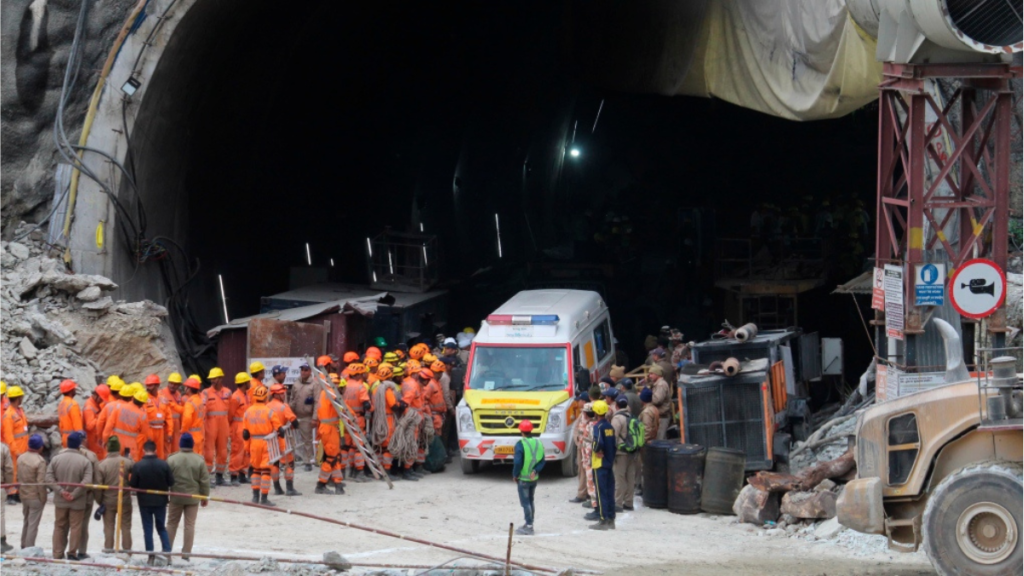41 workers trapped in a collapsed Himalayan tunnel in Uttarakhand, India, have been successfully rescued after 17 days. The rescue mission, which began with a landslide, was marked by setbacks and challenges. Two dozen “rat-hole” miners, known for their expertise in narrow tunnel navigation, were deployed to manually drill and clear the passage to the trapped workers. The trapped workers, mostly in their 20s, were brought out in wheeled stretchers through a narrow 90cm-wide pipe. The rescue effort was praised by President Droupadi Murmu, who acknowledged the indomitable spirit and collaborative efforts. The rescued men were reported to be in good health, and their condition was confirmed as “first-class and absolutely fine.” Critics attribute the tunnel collapse to rapid construction activities, particularly the Char Dham project, which threatens the region’s ecological balance. The rescue mission serves as a testament to the resilience of the human spirit and the strength of unity, determination, and collaboration in the face of adversity.
A Herculean Effort
The marathon rescue efforts faced numerous hurdles since the tunnel collapsed on November 12. The Silkyara tunnel is a crucial part of the $1.5 billion flagship Char Dham project, connecting key Hindu pilgrimage sites through two-lane roads in the Himalayas. A landslide had caused a portion of the tunnel to cave in, leading to a formidable 60-meter pile of rock and metal obstructing access to the trapped workers.
Rescue teams initially encountered challenges cutting through metal rods embedded in the rubble, and loose soil impeded progress. Despite optimistic announcements last Friday, the breakdown of the main drilling machine inside the tunnel compelled a strategic shift in the rescue operation.
Enter the “Rat-Hole” Miners
In a pivotal move, two dozen “rat-hole” miners, known for their expertise in narrow tunnel navigation, were deployed to manually drill and clear the passage to the trapped workers. Armed with handheld tools, they meticulously excavated the last few meters of debris, overcoming the breakdowns and setbacks that had plagued the rescue efforts.
The moment of triumph arrived as the trapped workers, mostly in their 20s, were brought out in wheeled stretchers through a narrow 90cm-wide pipe. The atmosphere outside the tunnel was one of jubilation, with friends, family, and local residents celebrating the rescuers’ success with cheers, flower garlands, firecrackers, and sweets.
Communication and Support
Throughout the ordeal, communication between those above ground and the trapped workers was maintained via walkie-talkies. The men were supplied with essential provisions, including oxygen, food, and water, through a separate narrow pipe.
President Droupadi Murmu expressed her relief and happiness on X (formerly Twitter), acknowledging the rescue effort as a testament to human endurance. The successful mission exemplifies the indomitable spirit and collaborative efforts that came into play.
Health and Wellbeing of the Rescued Workers
Despite the prolonged ordeal, the rescued men were reported to be in good health. An official from the National Disaster Response Force (NDRF) assured the public that their condition was “first-class and absolutely fine.” The workers were promptly taken to a nearby hospital for a thorough medical assessment.
Environmental Concerns and Infrastructure Development
Critics, including environmentalists and local residents, have attributed the tunnel collapse to rapid construction activities, particularly the Char Dham project. They argue that such endeavors contribute to land subsidence, posing a threat to the region’s ecological balance.
Hemant Dhyani, an environmentalist, highlighted the intensification of tunnel work in the last two decades, expressing concern about the mountains’ ability to withstand such massive infrastructure projects. The Uttarakhand region, known for its significance as the birthplace of the Ganges, sustains over 600 million Indians with water and food and plays a crucial role in India’s climate.
Conclusion: A Testimony to Human Spirit
The successful rescue of the 41 trapped workers is not just a testament to engineering prowess but also underscores the resilience of the human spirit. As the nation collectively held its breath during the 17-day ordeal, the unwavering dedication of the rescue teams and the courage of the trapped workers have left an indelible mark on India’s collective consciousness. The episode, while highlighting the challenges of rapid development in ecologically sensitive regions, also serves as a reminder of the strength that unity, determination, and collaboration can bring in the face of adversity.







